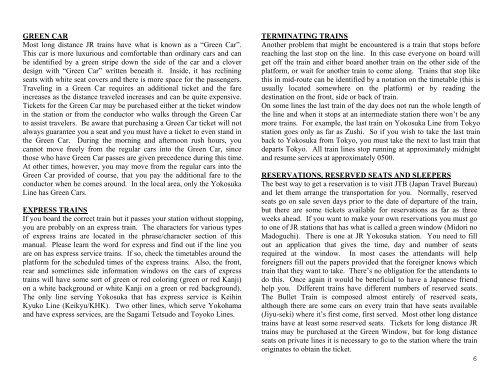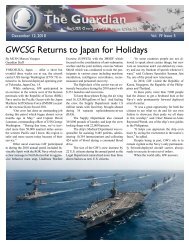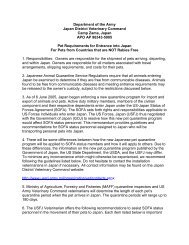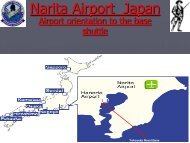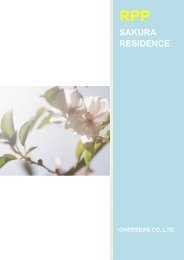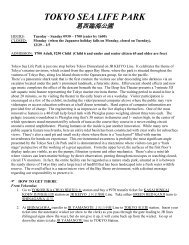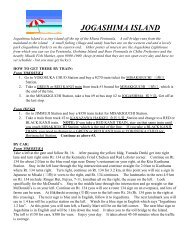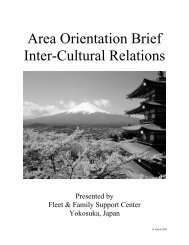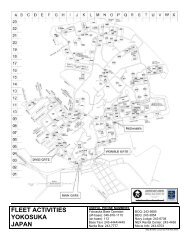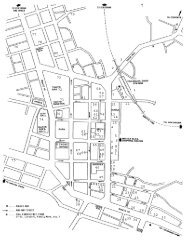TRAINS IN JAPAN
TRAINS IN JAPAN
TRAINS IN JAPAN
You also want an ePaper? Increase the reach of your titles
YUMPU automatically turns print PDFs into web optimized ePapers that Google loves.
GREEN CAR<br />
Most long distance JR trains have what is known as a “Green Car”.<br />
This car is more luxurious and comfortable than ordinary cars and can<br />
be identified by a green stripe down the side of the car and a clover<br />
design with “Green Car” written beneath it. Inside, it has reclining<br />
seats with white seat covers and there is more space for the passengers.<br />
Traveling in a Green Car requires an additional ticket and the fare<br />
increases as the distance traveled increases and can be quite expensive.<br />
Tickets for the Green Car may be purchased either at the ticket window<br />
in the station or from the conductor who walks through the Green Car<br />
to assist travelers. Be aware that purchasing a Green Car ticket will not<br />
always guarantee you a seat and you must have a ticket to even stand in<br />
the Green Car. During the morning and afternoon rush hours, you<br />
cannot move freely from the regular cars into the Green Car, since<br />
those who have Green Car passes are given precedence during this time.<br />
At other times, however, you may move from the regular cars into the<br />
Green Car provided of course, that you pay the additional fare to the<br />
conductor when he comes around. In the local area, only the Yokosuka<br />
Line has Green Cars.<br />
EXPRESS <strong>TRA<strong>IN</strong>S</strong><br />
If you board the correct train but it passes your station without stopping,<br />
you are probably on an express train. The characters for various types<br />
of express trains are located in the phrase/character section of this<br />
manual. Please learn the word for express and find out if the line you<br />
are on has express service trains. If so, check the timetables around the<br />
platform for the scheduled times of the express trains. Also, the front,<br />
rear and sometimes side information windows on the cars of express<br />
trains will have some sort of green or red coloring (green or red Kanji)<br />
on a white background or white Kanji on a green or red background).<br />
The only line serving Yokosuka that has express service is Keihin<br />
Kyuko Line (Keikyu/KHK). Two other lines, which serve Yokohama<br />
and have express services, are the Sagami Tetsudo and Toyoko Lines.<br />
TERM<strong>IN</strong>AT<strong>IN</strong>G <strong>TRA<strong>IN</strong>S</strong><br />
Another problem that might be encountered is a train that stops before<br />
reaching the last stop on the line. In this case everyone on board will<br />
get off the train and either board another train on the other side of the<br />
platform, or wait for another train to come along. Trains that stop like<br />
this in mid-route can be identified by a notation on the timetable (this is<br />
usually located somewhere on the platform) or by reading the<br />
destination on the front, side or back of train.<br />
On some lines the last train of the day does not run the whole length of<br />
the line and when it stops at an intermediate station there won’t be any<br />
more trains. For example, the last train on Yokosuka Line from Tokyo<br />
station goes only as far as Zushi. So if you wish to take the last train<br />
back to Yokosuka from Tokyo, you must take the next to last train that<br />
departs Tokyo. All train lines stop running at approximately midnight<br />
and resume services at approximately 0500.<br />
RESERVATIONS, RESERVED SEATS AND SLEEPERS<br />
The best way to get a reservation is to visit JTB (Japan Travel Bureau)<br />
and let them arrange the transportation for you. Normally, reserved<br />
seats go on sale seven days prior to the date of departure of the train,<br />
but there are some tickets available for reservations as far as three<br />
weeks ahead. If you want to make your own reservations you must go<br />
to one of JR stations that has what is called a green window (Midori no<br />
Madoguchi). There is one at JR Yokosuka station. You need to fill<br />
out an application that gives the time, day and number of seats<br />
required at the window. In most cases the attendants will help<br />
foreigners fill out the papers provided that the foreigner knows which<br />
train that they want to take. There’s no obligation for the attendants to<br />
do this. Once again it would be beneficial to have a Japanese friend<br />
help you. Different trains have different numbers of reserved seats.<br />
The Bullet Train is composed almost entirely of reserved seats,<br />
although there are some cars on every train that have seats available<br />
(Jiyu-seki) where it’s first come, first served. Most other long distance<br />
trains have at least some reserved seats. Tickets for long distance JR<br />
trains may be purchased at the Green Window, but for long distance<br />
seats on private lines it is necessary to go to the station where the train<br />
originates to obtain the ticket.<br />
6


